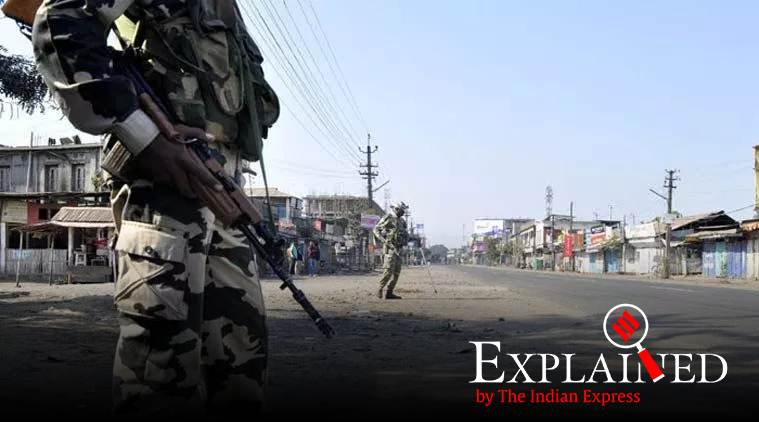- India
- International
Explained: How forces are tackling Maoists in Chhattisgarh, what challenges remain
While security forces have made continuous inroads, the Central Committee of the CPI (Maoist) has repeatedly admitted in various reports and meetings that their base area has shrunk, fresh recruitment almost dried up, and desertions increased.
 Though anti-Maoist operations do get restricted by various seasonal factors, these continue to be launched if there is actionable intelligence of Maoist movement
Though anti-Maoist operations do get restricted by various seasonal factors, these continue to be launched if there is actionable intelligence of Maoist movement
Seven Maoists were killed in an encounter with the Chhattisgarh Police on August 3 in the Bagnadi area of Rajnandgaon district bordering A week previously, on July 27, another seven had been killed in Machkot in Bastar. With these operations, over the last week, 16 Maoists have been killed. While security forces have made continuous inroads, the Central Committee of the CPI (Maoist) has repeatedly admitted in various reports and meetings that their base area has shrunk, fresh recruitment almost dried up, and desertions increased.
Traditionally, the monsoon has been considered a lean period in the conflict. What explains the Chhattisgarh police’s recent successes?
Though anti-Maoist operations do get restricted by various seasonal factors, these continue to be launched if there is actionable intelligence of Maoist movement. Further, security forces have learnt to overcome many impediments. Use of satellite technology helps in keeping track of jawans’ movement from any location, and the target can be identified with more clarity; staff trained in ‘battlefield nursing’ courses (conducted by the Army) can treat wounded jawans on the field itself; night helicopter landing facilities keep jawans motivated even at odd hours.
Therefore, irrespective of the monsoon in full swing at both Machkot and Sitagota-Sherpar jungles, the police with convincing intelligence were able to launch operational teams and emerge successful. In both instances, security forces were successful in recovering weapons and the bodies of the deceased Maoists without suffering a single casualty (except for injury to one jawan).
Of late, local police in the form of DRG (District Reserve Guard) have been more and more successful in countering Left Wing Extremism (LWE). What has made this possible?

Chhattisgarh’s state police, with the support of specialised training institutes (CTJW College, Kanker and four CIAT Schools) have built up capacity and raised specialised forces. The Centre, besides helping the state strengthen training capacity and capabilities, is also providing financial support to strengthen the specialised wings of STF (Special Task Force) and SIB (State Intelligence Bureau).
The two STF battalions are capable of countering Maoists’ ‘main force’ which chiefly consists of military Battalion No. 1 and is active in south Bastar. DRGs have been constituted in many districts consisting of local policemen of affected areas. They not only have the best knowledge of the terrain but are also well-versed in the local dialect. Their natural instincts have been supplemented with professional ethos from the Counter-Insurgency and Jungle Warfare School of Vairengte, Mizoram. While both STF and DRG played a pivotal role in the Machkot encounter, DRG of Rajnandgaon with able leadership led the operation.
The August 3 encounter was in the proposed ‘MMC Zone’, which was described in a 25-page Maoist document and reported by The Indian Express in 2017. What is the nature of the threat, and how can it be combated?
The CPI(Maoist), following a decision taken in the 2014 Central Regional Bureau (CRB) meeting, is trying to develop the new MMC Zone. This is where Maharashtra, Madhya Pradesh and Chhattisgarh meet, broadly the districts of Gondia in Maharashtra, Balaghat in Madhya Pradesh, and parts of Rajnandgaon, Kabirdham, and Mungeli in Chhattisgarh. Maoists intend to create an entity like the Dandakaranya (DK) Special Zonal Committee in Bastar. This area is predominately tribal, forested and hilly and suitable for guerrilla warfare. It is also contiguous to the North Gadchiroli Maoist Division of the DK. Except for a few, most of the cadres in the MMC Zone were transferred there from Bastar.
The state governments took proactive steps by deploying additional resources and are trying their best to check Maoists’ expansion. In Chhattisgarh, many new police stations and security camps have been established. The SP, Kabirdham, organised a number of awareness campaigns in remote areas which are most vulnerable to Maoist influence. He made arrangements for villagers’ training and facilitated government employment for hundreds. The administration has taken steps to expedite developmental work. Madhya Pradesh and Maharashtra too have intensified anti-Maoist operations in these areas. Though the Maoists are yet to find their roots here, the efforts need to be continued. The Darrekasa Area Committee of the Gadchiroli-Rajnandgaon-Balaghat (GRB) Division of MMC was almost wiped out on August 3.
What went wrong in the attack on C-60 commandos in an “open area” of Gadchiroli on May 2 this year?
In the guerrilla zone (in addition to hilly and forested terrain) open areas leave security forces vulnerable as most Maoists, being from DK, can easily conceal their identity and mingle with locals. In such areas, Maoists carefully survey the modus operandi of security forces and only then lay an ambush or attack. What I could gather from the May 2 attack is that perhaps the road was not dominated by the police as per laid down standard operation procedures. In the wake of the preceding incident of Maoists setting on fire about three dozen vehicles engaged in road construction work, this ought to have been all the more important. Still, it will not be appropriate to label this incident as a failure of commandos, but it was a professional hazard security forces have to put up with.
Despite the last two successful encounters, don’t Maoists retain the ability to strike back soon after suffering a major setback — like the Maoist attack in Kurkheda of Maharashtra, after 50 Maoists had been killed in Gadchiroli in April 2018?
If we analyse the pattern, most such attacks have taken place during the ‘Tactical Counter Offensive Campaign’ (TCOC) period which generally extends from February-March to May-June each year. During this TCOC period, most of their field formations (political as well as military) join together to form area or division command (which are much bigger in size) and launch major attacks. Thus, despite the fact that the overall strength of the CPI (Maoist) has thinned and the capacity of the security forces has improved, Maoists can still manage to strike security forces and cause casualties this way. The security forces therefore need to be extra vigilant during this TCOC period.
What is the best way to fight IEDs, like the one used in Kurkheda or the one that blew up an MPV in Sukma in March 2018?
One way to avoid destruction and casualties caused by IEDs is to ensure that these are successfully detected through visual surveillance or using technical gadgets and defused in time. Second, a road opening party may dominate the surrounding area thoroughly enough to make certain that no suspicious elements are hiding around to trigger IEDs. Third, law-enforcement agencies can crack down on miscreants who supply explosive substances to the Maoists. Fourth, explosive substances and most importantly detonators can be made identifiable at the production stage using a unique number for identification. However, all these measures have their limitations. Also, the use of IEDs, being inhumane, must be condemned by all at appropriate international forums.
What is the way forward for security forces here on?
Though, Maoists have weakened in DK, Odisha State Committee and other zones, and their expansionist policy is under check, security forces cannot afford to ignore their protracted war strategy. The mobile war (capability to attack at will in base areas and escape unscathed) has to be reversed and the areas of security vacuum (where there is no presence of the security forces) plugged. Better technologies, including Ground Penetration Radar, are required to detect and defuse IEDs. Security forces also need to learn from previous tactical errors and adhere to time-proven SOPs. The information network should improve with better road and telecom
connectivity in far-flung areas. Surrender and rehabilitation policies must be implemented in letter and spirit. The administrative and political vacuum in remote areas must be filled.
‘The Forest Rights Act’ should be interpreted in favour of forest dwellers. The root cause of the problem that is exploited by the Maoists —socio-economic deficits — must be bridged. The human rights of the local populace must be protected by the administration and security forces if the credibility of efforts so far is to be established.
R K Vij is Special DGP, Chhattisgarh. He was formerly the state’s Additional DGP, anti-Maoist operations.
More Explained
EXPRESS OPINION
Apr 19: Latest News
- 01
- 02
- 03
- 04
- 05








































